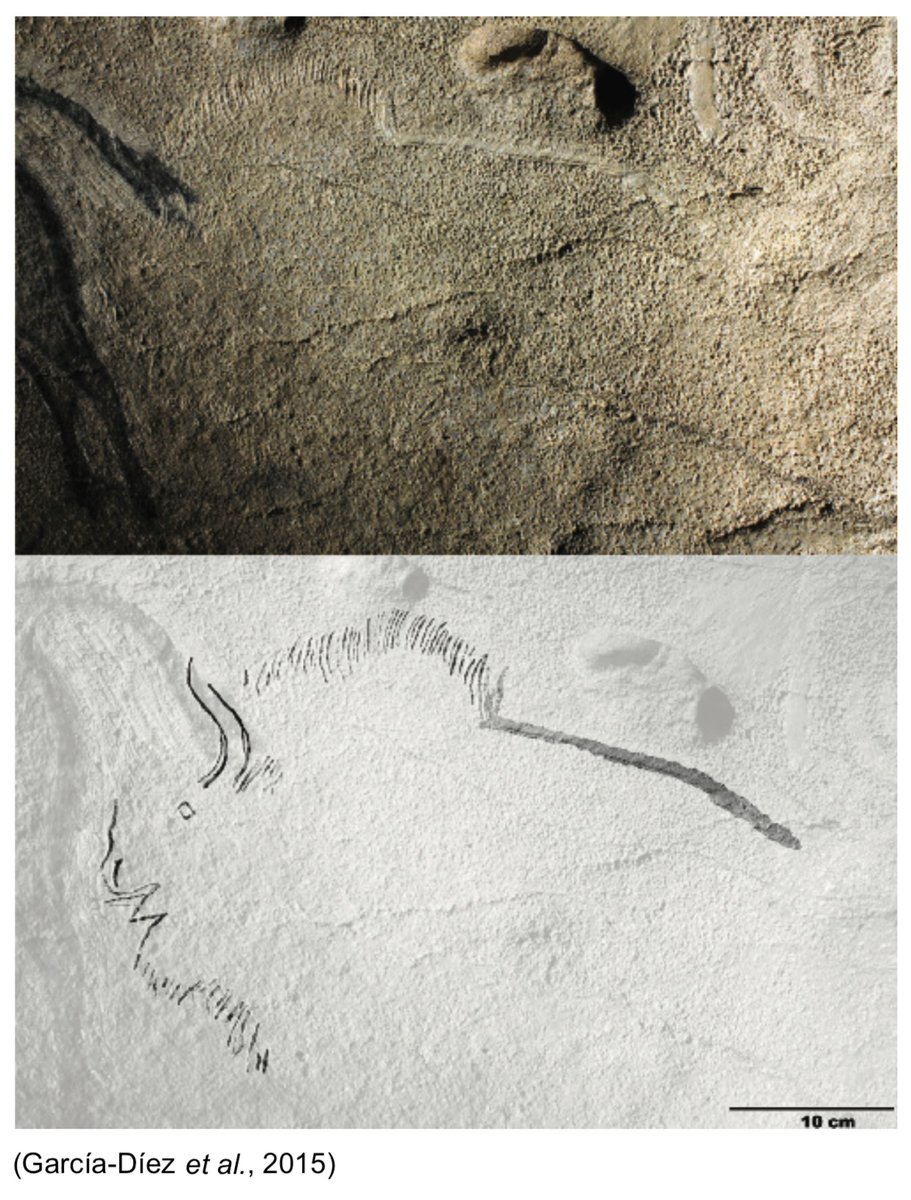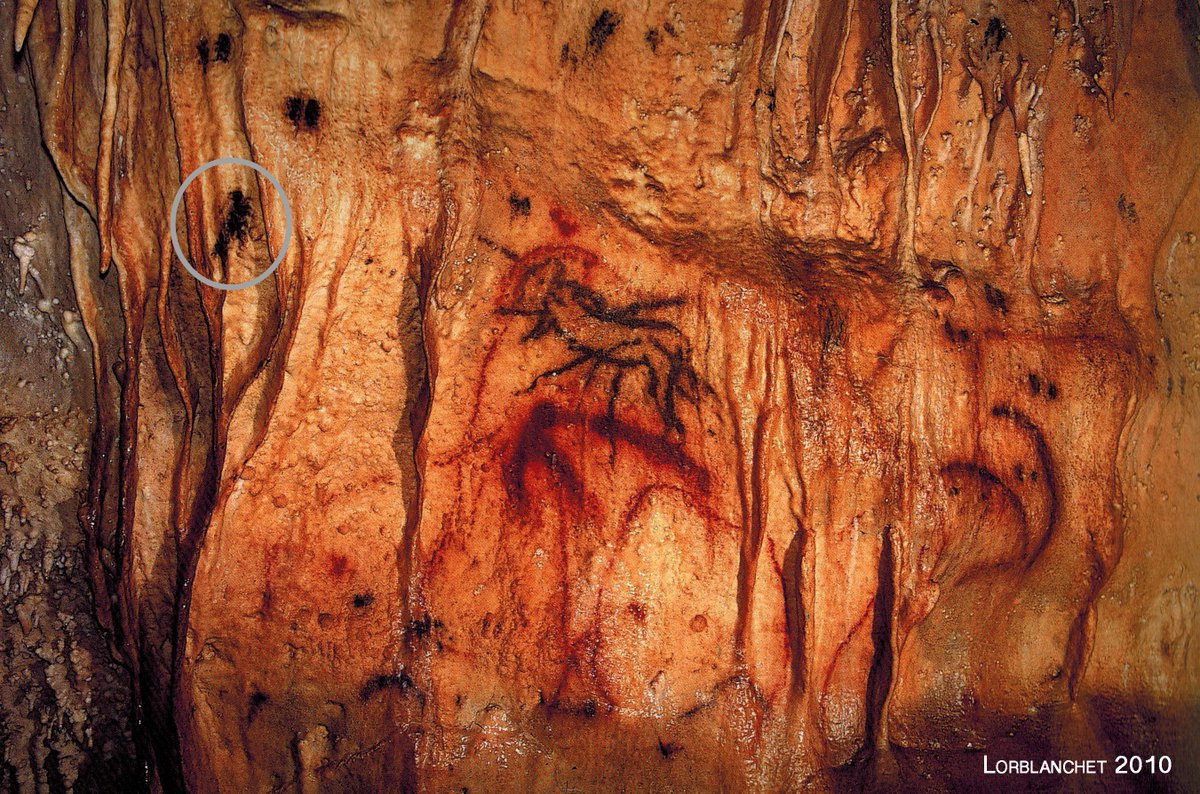Discover and read the best of Twitter Threads about #Fridaypaleoart
Most recents (13)
Good morning in this #FridayPaleoArt!!🖐️😌
Today we visit one of the two only decorated caves of Corrèze in France (along with Moulin de Laguenay)...
Cave: #PuyJarrigeII
Place: Brive, Corrèze (France)
Motif: bison
Chronology: premagdalenian
Today we visit one of the two only decorated caves of Corrèze in France (along with Moulin de Laguenay)...
Cave: #PuyJarrigeII
Place: Brive, Corrèze (France)
Motif: bison
Chronology: premagdalenian

☕️Good morning to all! In today’s first #FridayPaleoArt of #October1st we are going to look for the prehistoric hunters through Paleolithic art.
Cave: #PechMerle
Place: Cabrerets, Lot, Francia
Motif: Wounded Man. Gallery of the Wounded Man
Chronology: Possibly #Solutrean
👇😉
Cave: #PechMerle
Place: Cabrerets, Lot, Francia
Motif: Wounded Man. Gallery of the Wounded Man
Chronology: Possibly #Solutrean
👇😉

🪔Hi! 📆Today is #EuropeanResearchersNight, but it is also #FridayPaleoart, so we are going to travel to...
Cave: #Covaciella
Place: Cabrales, Asturias (Spain)
Motif: Bison
Chronology: #Magdalenian
Cave: #Covaciella
Place: Cabrales, Asturias (Spain)
Motif: Bison
Chronology: #Magdalenian

👋🤔💭Hi friends! Today is #FridayPaleoArt and we are going to cheer up this september, visting an open air site, recenlty discovered…⁉️
Site: #LaSalud
Place: Salamanca (Spain)
Motif: Horses
Chronology: Pre-Magdalenian
Site: #LaSalud
Place: Salamanca (Spain)
Motif: Horses
Chronology: Pre-Magdalenian

Hi friends! 👋🏽 This #FridayPaleoArt we will move away from the rainy lands of the north to visit an extraordinary cave in the south 🌞
Cave: #Navarro
Place: Málaga (Spain)
Motif: ideomorphs
Chronology: Pre-Magdalenian
Cave: #Navarro
Place: Málaga (Spain)
Motif: ideomorphs
Chronology: Pre-Magdalenian

We refer to the Cueva de Navarro, located in the province of Malaga (Andalusia, Spain), in the extreme south of Europe.
The cave was discovered by chance in 1979, when its galleries were intercepted by the Navarro Quarry front, and it was published for the first time in 1981 by José Luis Sanchidrián 📖🔎.
🙋♀️Hi everyone! Today is #FridayPaleoArt and we’re visiting Chufín cave in Cantabria, one of the @UNESCO World Heritage sites of Cantabrian Region.
Cave: #Chufín
Place: Riclones (Cantabria, Spain)
Motif: Red paintings and engravings
Chronology: #Premagdalenian
Cave: #Chufín
Place: Riclones (Cantabria, Spain)
Motif: Red paintings and engravings
Chronology: #Premagdalenian

Hi friends! ✨ Today is #FridayPaleoArt and we're moving to French Pyrenees to visit an excellent cave ⛰.
Cave: #Marsoulas
Place: Marsoulas (Haute-Garonne, Francia)
Motif: horse, aurochs, goat, ideomorphs, etc.
Chronology: #Magdalenian

Cave: #Marsoulas
Place: Marsoulas (Haute-Garonne, Francia)
Motif: horse, aurochs, goat, ideomorphs, etc.
Chronology: #Magdalenian


This #FridayPaleoart we look at the history of the #interdisciplinaryresearch.
𝐃𝐨 𝐲𝐨𝐮 𝐤𝐧𝐨𝐰 𝐭𝐡𝐞 𝟏𝐬𝐭 𝟏𝟒𝐂-𝐀𝐌𝐒 𝐝𝐚𝐭𝐢𝐧𝐠 𝐨𝐧 #𝐏𝐚𝐥𝐞𝐨𝐥𝐢𝐭𝐡𝐢𝐜𝐀𝐫𝐭?🔬⚫️🧪
Cave: #Cougnac cave
Place: Lot, France
Motif: Wounded man, animals and marks
Chrono: Multiphase
𝐃𝐨 𝐲𝐨𝐮 𝐤𝐧𝐨𝐰 𝐭𝐡𝐞 𝟏𝐬𝐭 𝟏𝟒𝐂-𝐀𝐌𝐒 𝐝𝐚𝐭𝐢𝐧𝐠 𝐨𝐧 #𝐏𝐚𝐥𝐞𝐨𝐥𝐢𝐭𝐡𝐢𝐜𝐀𝐫𝐭?🔬⚫️🧪
Cave: #Cougnac cave
Place: Lot, France
Motif: Wounded man, animals and marks
Chrono: Multiphase

This pioneer #14CAMSdating was carried out on a sample of pigment from a black punctuation of this wall👆⚫️. The analysis was executed by H. Valladas, H. Cachier and M. Arnol of #CNRS (Laboratory Gif-sur-Yvette). RESULT: 14290 +-180 BP 

The Spectrometric Mass Accelerator (AMS) applied on radiocarbon analysis revolutionized the Archeology (and of the Paleolithic Art study, of course!). This first dating was carried out in #Tandetron accelerator and with only 0.80 mg of datable carbon (sample AFTER pretreatment).
Hi there! This #FridayPaleoArt we are on holidays, so we woke up late! 🤭Let's go!
Cave: #Cualventi
Place: Oreña, Alfoz de Lloredo, Cantabria
Motif: Deer
Chornology: #Magdalenian
Cave: #Cualventi
Place: Oreña, Alfoz de Lloredo, Cantabria
Motif: Deer
Chornology: #Magdalenian

🗺️Cualventi Cave is located in the district of Perelada (Oreña, Alfoz de Lloredo, Cantabria), 2 km from Altamira. The cave opens in the wall of a wide and shallow doline, inside a small valley close to the coast. 

⁉️ It's a large rock shelter with two openings. The lower one, #LaCovacha, is a small cave linked with the karst system and was obstructed during the Magdalenian. The upper one, #Cualventi, is located 4m above and provides direct access to the fossil floors of the karst. 🤔 

👋😎Hi friends! to say goodbye in this #Fridaypaleoart to the month of July we are going to visit a small but fascinating cave:
Cave: #Lluera I
Place: San Juan de Priorio (Asturias, España)
Motif: horse, aurochs, deer.
Chronology: #Premagdalenian
Cave: #Lluera I
Place: San Juan de Priorio (Asturias, España)
Motif: horse, aurochs, deer.
Chronology: #Premagdalenian

Welcome to another warm summer morning! 👋😎(or at least that's what we hope!) 🤓
Today is #FridayPaleoart and we are going to visit a recently discovered site... 👇😉
Cave: #Danbolinzulo
Place: Zestoa, Gipuzkoa
Motif: Red painted and engraved goat
Chronology: #Premagdalenian

Today is #FridayPaleoart and we are going to visit a recently discovered site... 👇😉
Cave: #Danbolinzulo
Place: Zestoa, Gipuzkoa
Motif: Red painted and engraved goat
Chronology: #Premagdalenian


⁉️This is a really small cave (with least than 30 meters of development), currently accessed through a small hole in #Ertxiña mountain.
💭It would be interesting to known how was the cave during the Upper Paleolithic. ➡️Currently, there are a lot of blocks and some speleothems.
💭It would be interesting to known how was the cave during the Upper Paleolithic. ➡️Currently, there are a lot of blocks and some speleothems.

❗️The cave is small, but it is very well placed over a narrowing of #Urola valley.
☝️😌It was known by @Antxieta_Taldea in 1980 when they located some post-paleolithic remains, but in 14th of dec. of 2014, they found red paintings inside, confirmed as paleol. by @MGarcia_Diez.
☝️😌It was known by @Antxieta_Taldea in 1980 when they located some post-paleolithic remains, but in 14th of dec. of 2014, they found red paintings inside, confirmed as paleol. by @MGarcia_Diez.

👋😉Hi! Today is #FridayPaleoart, and instead of a single site, we are going to visit an entire valley!!! #KarrantzaHarana 🏞️
Cave: #ArcoB cave
Place: Pondra, Karrantza river valley, Ramales de la Victoria, Cantabria (Spain)
Motif: Mammoth
Chronology: #Premagdalenian
Cave: #ArcoB cave
Place: Pondra, Karrantza river valley, Ramales de la Victoria, Cantabria (Spain)
Motif: Mammoth
Chronology: #Premagdalenian

➡️⁉️The Carranza River is a short river that rises in Karrantza (Bizkaia) and connects with the Asón River in Ramales de la Victoria (Cantabria). The Carranza gorge is the only way out of the valley and is characterized by an abrupt karstic orography plenty of caves and shelters. 

❗️📚More than twenty archaeological sites are known (27) although the archaeological information in many cases is deficient. There are 7 decorated caves, 5 in Cantabria and 2 in the Basque Country.
Good Morning! Today is not a #NovemberRain-y day, but it is #FridayPaleoart, so we are going to visit a sheltered place in... ☂️
Cave: #Etxeberri
Place: Camou-Cihigue, Zuberoa, Pays Basque, Nouvelle Aquitaine (France)
Motif: Black bison and red stains
Chronology: #Magdalenian

Cave: #Etxeberri
Place: Camou-Cihigue, Zuberoa, Pays Basque, Nouvelle Aquitaine (France)
Motif: Black bison and red stains
Chronology: #Magdalenian


Etxebarri is a pyrenean cave with #Magdalenian rock art, placed in the beautiful massif of Arbailles, in the hearth of #Zuberoa, #BasqueCountry.
The bison we have presented here is not especially wonderful, but it stands out because of its location deep inside the cave. 👇😉

The bison we have presented here is not especially wonderful, but it stands out because of its location deep inside the cave. 👇😉

























